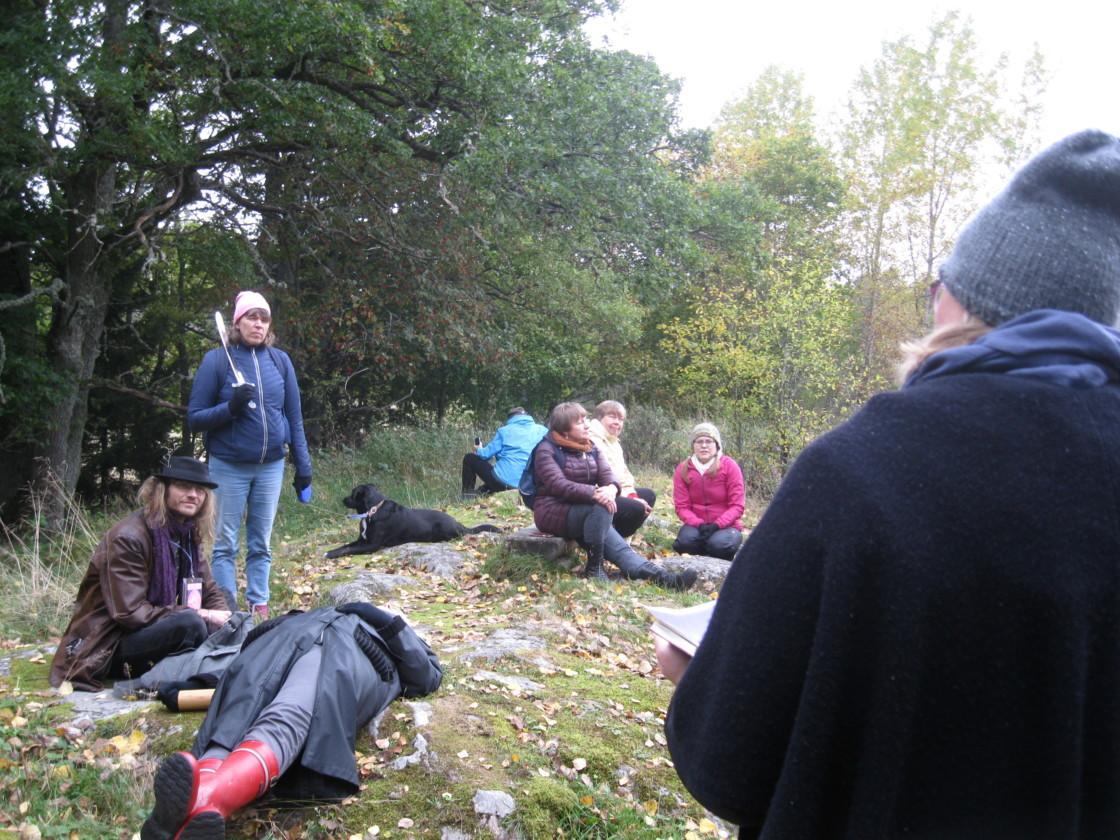Context:
Design researcher Kirsi Hakio worked with the custodians of Elisaari island in Finland to develop a set of ‘awareness-based’ service design methods that help people to tune in to their inner worlds and think of themselves as connected to wider ecosystems. Elisaari island sits off the coast of Helsinki and is accessible to the public for recreation from May to October. Although it is owned by the city, it is managed by an entrepreneurial couple, who run nature-based tourism services there including a café, boating services and camping facilities. Hakio was interested in working with these custodians to develop new services. However, she soon found that traditional service design methods couldn’t adequately account for the island’s main stakeholder: nature. She began exploring new techniques to connect with Elisaari’s human and non-human stakeholders.
“Mainly it’s inhabited by the non-humans, the animals the plants, the nature – they really own the place, and then people come part-time in the year.” – Kirsi Hakio
Connections to eco-social sustainability:
Hakio is interested in the inner dimensions of sustainability: our personal modes of sense and meaning-making that we each carry around with us, which deeply influence our everyday choices.
“Our inner world really animates our actions…our inner conditioning and mental models and the worldviews that we have – even though we may not notice it, they effect how we behave, how we make decisions how we encounter others – humans and non-humans” – Kirsi Hakio
Hakio created a series of co-design workshops that brought together stakeholders from Elisaari to help them to recognise and share these unspoken assumptions. At the first workshop she trialled awareness-based exercises that asked participants to become present and observe what was happening inside their minds and bodies. This was followed by dramaturgical exercises where participants used their bodies to take on different roles and to act out scenarios for future services, which enabled participants to visualise and share their own inner lives and orientations with the group.

Speculative design workshop on Elisaari island, Kirsi Hakio 
Speculative design workshop on Elisaari island, Kirsi Hakio
Transformative creative practices:
The second set of workshops took place on Elisaari island and focussed on generating empathic connections to the non-human stakeholders. A series of walking meditations helped participants to connect more deeply to the place. Hakio also asked participants to assume the role of animals, trees, historical figures and nature spirits from Elisaari. She then interviewed the participants in character using classic service design questions, asking someone acting as a deer or a rock how they would ensure repeat customers. All of these activities were designed to give participants the experience of being deeply connected to a wider ecosystem of which they were one part of a larger whole: an experience of the ‘ecological self’ (Bragg, 1996).
“Participants see themselves as part of this interconnected worldview… and I think in that state they want to start changing their behaviour… they are having experiences that are very difficult to explain to others maybe of connectedness and of connecting to the place.” – Kirsi Hakio
However Hakio notes that the challenge in sustaining these motivations beyond the workshop experience.
“when participants enter home it’s really difficult to maintain because the environment is completely different… It’s really difficult to turn those experiences into actions… I see how the custodians of the island are living in that kind of state all the time. So I’m not sure if we’re supposed to be in that bubble for a longer time – because usually we don’t have time and resources – or if we need to build our communities differently.” – Kirsi Hakio
In the later phase of the Elisaari project Hakio worked with the island’s custodians to develop co-design techniques for the orientation of new employees. These helped the group to co-create shared values that subsequently went on to influence the working culture of the island. Awareness-based approaches provide ways to intervene in the interactions between people and place, by opening up space to articulate different mental models and bring alternative worldviews into being. Hakio’s work challenges us to think about how awareness-based methods might be used beyond service design to prompt cultural and social change. What might we need to change about our material and social worlds for people to act as their ecological selves all the time?
Nominator:
“We were walking through the forest in different roles. I walked with someone who was a sheep…I had to think through the nature materials and how we could bring that into the catering….it was more or less play around with the idea, but it was such a change maker to my, my thinking is, I’ll never forget.” – Tuuli Mattelmäki
Project credits:
Funded by Aalto/Department of Design.
Learn more:
Hakio, K. (2021). The New Paradigm Is Already Here: The Practicing of Prototypes of Future through Vertical Alignment. Journal of Awareness-Based Systems Change, 1(2), 73-94. https://doi.org/10.47061/jabsc.v1i2.939
Hakio, K., & Mattelmäki, T. (2019). Future skills of design for sustainability: An awareness-based co-creation approach. Sustainability, 11(19), 5247. https://doi.org/10.3390/su11195247